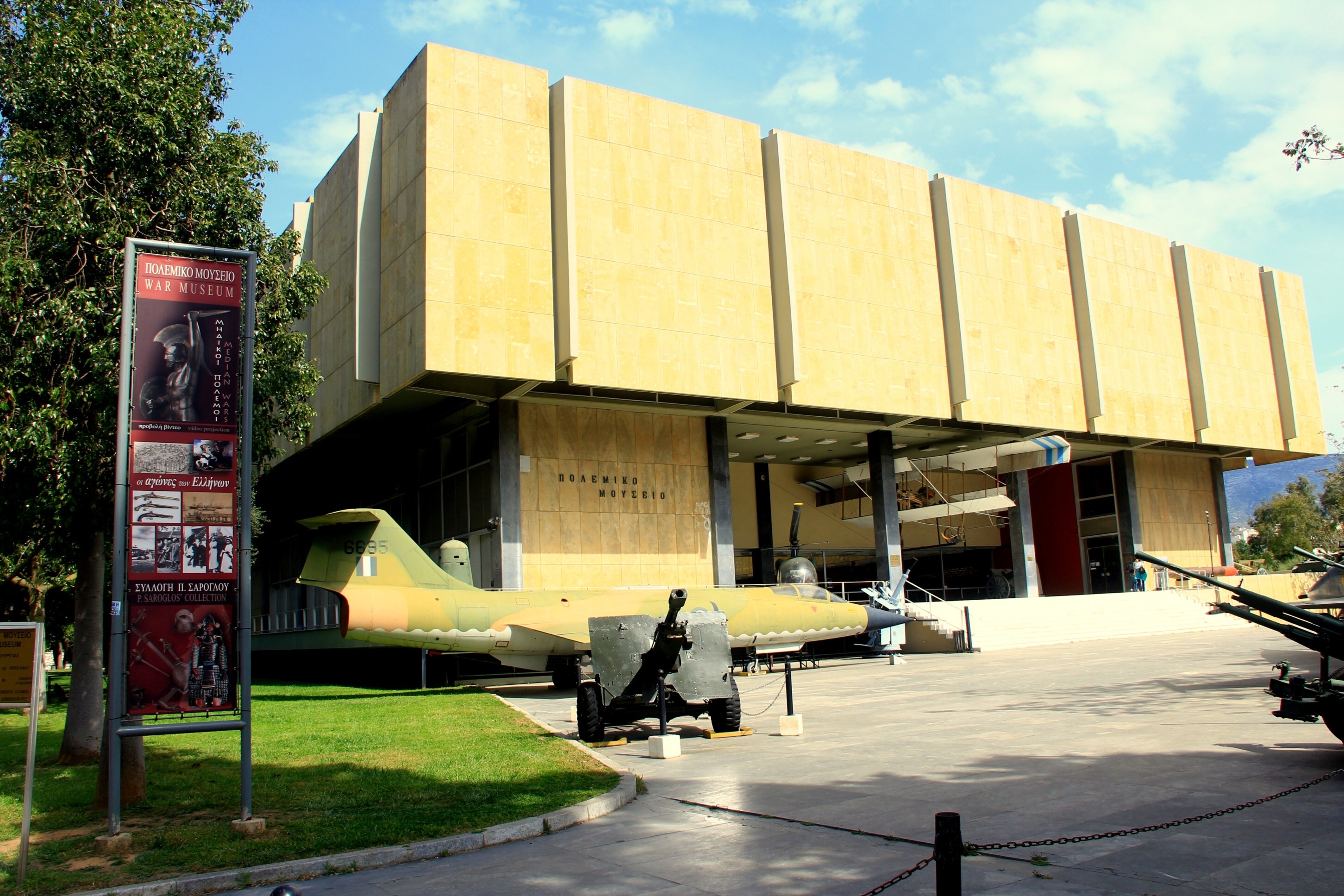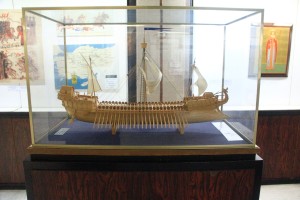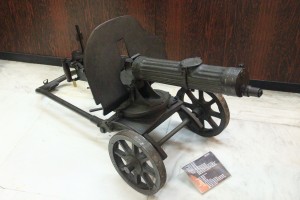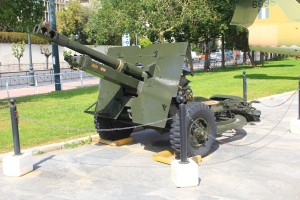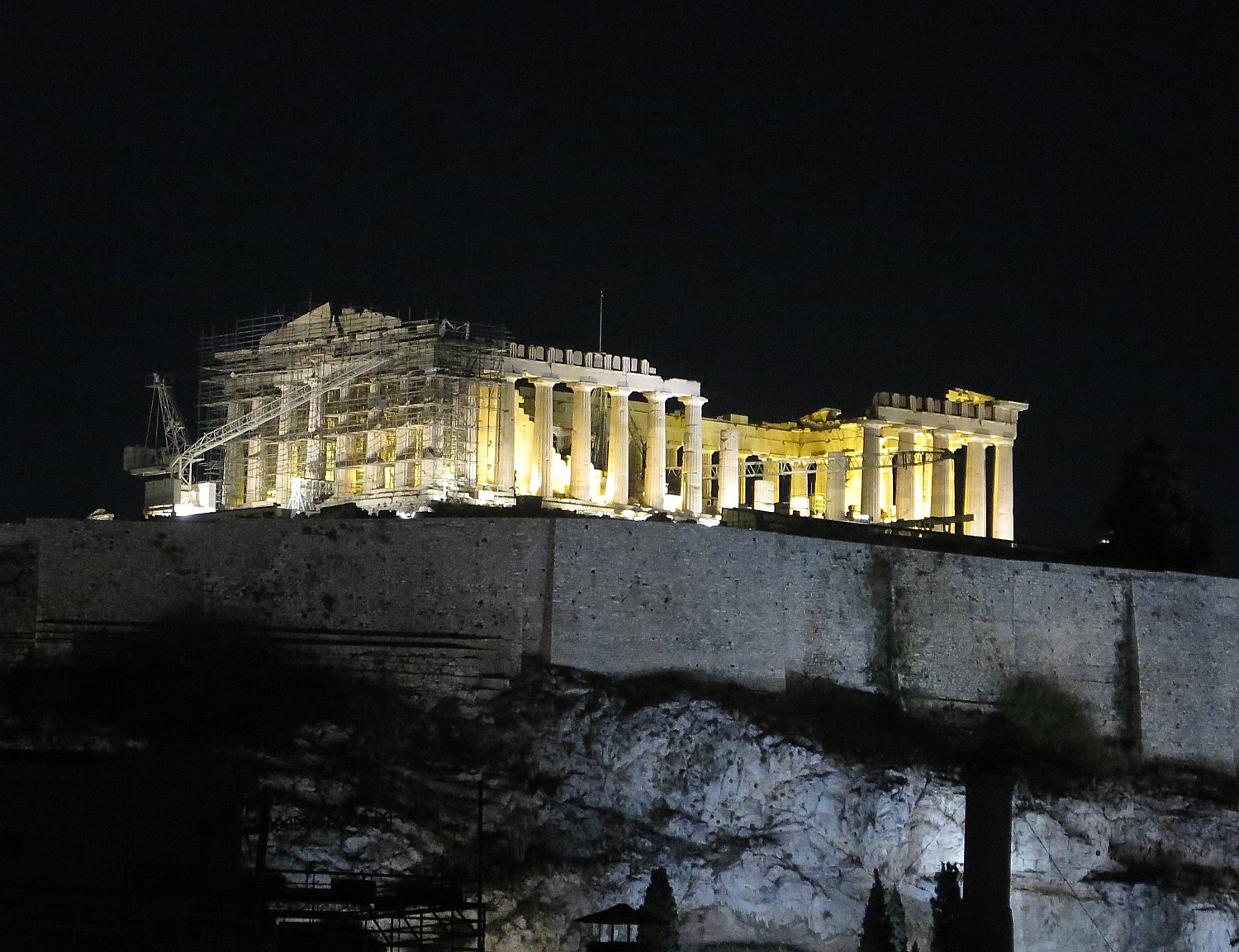
By Karen Rubin, Travel Features Syndicate
If you only have a single day to spend in Athens, resist the temptation to rush to the Acropolis Hill and the New Acropolis Museum first – these most popular sites in the city which birthed democracy and Western Civilization, are overrun by 9 am with tour groups (though you can visit as early as 8 am), creating a line of people like ants and a cacophony of sound like a noisy schoolyard. Instead, here is an itinerary that gives you the full span of history and culture and gives you time to really appreciate the marvels on display.
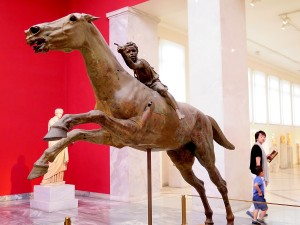
9:15 am: Start the day at the National Archaeology Museum, a 10-15 minute walk from the Omonia Metro Station (1.2E, about $1.50 a ride, or 4E for a full day of travel).Take a guided tour (50E for up to five people – we were lucky enough to have Andromache as our guide, Andromache.vl@gmail.com) – otherwise, you will be awed by what you see, but not understand their importance or context, even with the good labels and explanations in English. This is a spectacular museum that is not to be missed – only place where you will see archaeology representative of all regions of Greece over all its eons and periods (even surpassing the Metropolitan Museum of Art’s collection, and what a marvel to see the items in context): beginning with the Neolithic period, 6500-3300 BC (and what extraordinary pieces! including gold objects and stunning clay figures that showed a devotion to Mother Earth, Gaia, and hinted at the matriarchy that preceded a patriarchal religion and society).
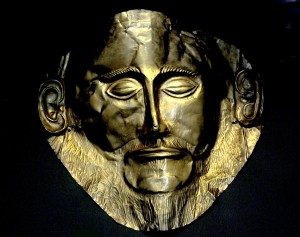
You will be able to see the Golden Mask of King Agamemnon, excavated by Heinrich Schliemann at Mycenae in 1876, (which we learn is actually centuries older than Agamemnon’s reign, but they keep the name for “marketing” purposes), spectacular gold ornaments and funeral objects that suggest a belief in an afterlife, There are two of only five full-scale bronzes left in the world – one, a national symbol of a standing god (Zeus or Poseidon, it isn’t clear because the tool that he would have held, a lightening bolt or a trident, perhaps, has been lost to time) was saved because as it was being taken to Rome by boat to be melted down for weapons, the boat sank and was found in 1926 by fisherman, plus a bronze statue of an African boy on a racing horse that was saved by being shipwrecked, made during the time of Alexander the Great, when the expansion of Greek’s empire brought exotic themes into the art (Alexander was also the first person to have a portrait in a statue). You also see a vase with the first sentence (or rather, the oldest known sentence) written in Greek language: “Now I belong to the man who is the best dancer.” (I think to myself, what pressure on a person to write the first sentence to go down in history! Or, for that matter, the inventor of the “space” between words, which had not existed in Greek.).
Also, there is an astonishing special exhibit,” The Antikythera Mechanism,” about an astrological clock invented in 150-100 BC – centuries before Columbus used an astrolobe to explore the globe – that could predict planetary events 19 years ahead. The Mechanism, made with the precision of a Swiss watchmaker (how did they get the parts so thin and flat?), was found in 1900-1, in the wreck of a ship sunk off Antikythera. Seven large fragments and 75 minor pieces have survived. “Their exact position and the original structure of the Mechanism are still a matter of intense investigation,” though an extraordinary video suggests how the machine, containing at least 30 gearwheels as well as dials, scales, axles and pointers, was put together. The notes say that the Greek astronomical inscriptions on the surface of the Mechanism refer to astronomical and calendar calculations, while the inscriptions on its metal protective plates contain instructions for its use. The Mechanism was protected by a wooden case, which had a bronze plaque on the front and the back side.
“The Antikythera Mechanism is the earliest preserved portable astronomical calculator. It displayed the positions of the Sun, the Moon and most probably the five planets known in antiquity, Mercury, Venus, Mars, Jupiter and Saturn. It was used to predict solar and lunar eclipses, it kept an accurate calendar of many years, and displayed the date of Pan-Hellenic games that took place at Nemea, at Isthmia, at Delphi, at Dodona and at Olympia.
“Its construction dates to the second half of the 2nd century BC. Its technology, which recalls the successors of Archimedes and the school of Poseidonius on the island of Rhodes, was the result of the development of philosophy and of exact sciences that took place in Greece until this era, and also draws on knowledge of the Hellenistic Age (celestial parameters, mechanical design and use of epicyclic gearing). The Mechanism bears witness to the astronomical, mathematical andmechanical ingenuity of ancient Greeks in Late Hellenistic period.”
It was the computer, the cell phone and the calculator of its day, and makes you realize that in every age, it only takes one genius to transform the world.
(National Archaeology Museum, 44 Palision St., www.namuseum.gr)
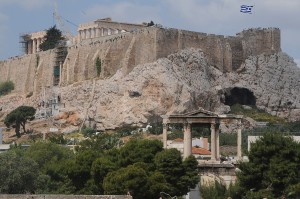
11:30 am: From the National Archaeology Museum, hop back on the metro (the stations are beautiful, and each one features an exhibit of archaeological discoveries excavated when they dug the metro, but you are repeatedly warned to watch out for pickpockets, and we personally know several people who were in fact pick-pocketed) to the Acropolis stop, and walk through Hadrian’s Gate (the original entrance to Athens), to the Temple of Olympic Zeus, one of the largest temples in Greece.
12:15 pm Walking through the Plaka, we stop for lunch under an umbrella, beside an arbor – relaxing and checking WiFi (just about all the tavernas have free WiFi. Greece offers exceptional value now – not only is the dollar strong against the Euro, but prices in Greece have been cut with the economic downturn, to make them more affordable. Our lunch cost less than 30E for 3 people, or about $10.
1:15 pm We walk past The Library of Hadrian (a gift of the Roman Emperor supporting education and exercise in Athens) and the Roman Agora (a commercial marketplace) in order to have enough time in the Ancient Agora – an exceptionally important site, where you will stand over the first House of Parliament, literally the birthplace of democracy.
You need to allocate at least one hour at the Ancient Agora in order to have time to visit a superb museum, housed in the reconstructed Stoa of Attalos, a 2nd C BC building that was restored in 1952-56 by the American School of Classical Studies to exhibit the artifacts collected at the site (it was renovated in 2003-4). Here you will see how citizens (a minimum of 6000 were necessary) could vote to “ostracize” a politician accused of corruption. (Pericles, who we regard today as marshalling the Golden Age of Greece, received 43 of these “votes” recorded by scratching the name into a broken piece of pottery; to avoid prosecution, which could have resulted in being exiled for 10 years, Plutarch suggests that Pericles started the Peloponnesian War).
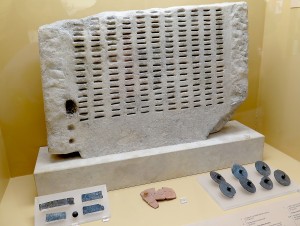
You also see the lottery system used to pick jurors (they paid 1/3 drachma to buy a strip in which to write their names, and if selected, would receive a drachma’s pay), and the devices used to record their verdict. Also, there are a collection of small cups used by prisoners to take hemlock – one of the cups could well have been used by Socrates, who was sentenced to death for teaching the heresy of denying 12 gods at a time when paganism was the official religion (he supported the idea of a single spirit, which gets me thinking that he might have been influenced by the Jewish community that was already established in Athens at the time – in fact, we visit the site where signs, etched in marble, announced the Jewish synagogue, near where the House of Parliament stood. The original artifacts are at the museum, but not on display).
Then walk down the street lined with statues of Giants (in Greek tradition, Titans were first, then the Giants, then the Olympian gods), to a headless torso of the Roman Emperor Hadrian, who respected and admired Athenian culture and enhanced it with his Library and other institutions, but threw Christians to the lions (and wasn’t so great for Jews, either). The homage paid to him by Athenians was shown in the decoration on his breastplate, depicting the goddess Athena standing on a wolf suckling the twins, Romulus and Remus, the mythical founders of Rome. But the headless statue was contemptuously thrown into the sewage ditch by early Christians (who also defiled the Parthenon and most of the statues denoting devotion to paganism), and only discovered in the sewer when they excavated.
The Hadrian Statue stands near the Bouleuterion, or Council House, where the 500 representatives of the 10 tribes met, would have been – in essence, the first House of Parliament.
Above, on a hillside, is the beautiful Temple of Hephaistos (5th C BC) but just to the side is believed to have been a synagogue, serving a Jewish community that had existed in Athens at least since 3 rd C BC and possibly as early as 6th C BC. This is based on finding etched marble – in essence, a sign for the synagogue, which comes from the Greek words “synagein,” which means “to bring together” and the same root word as “agora” which means “a place of assembly.”
The Agora was the political center for Athens, and because it was a gathering place, also became a commercial center. It was there that courts were held (but capital crimes were tried outside its boundary, so the blood on a murderers’ hands not pollute the public space).
2:30 pm: Walk around the Acropolis Hill up Apostolou Pavlou, a beautiful wide cobblestone boulevard, lined with crafts people, street musicians (and virtually no cars), where you also see ruins of early neighborhoods, as well as peer into contemporary neighborhoods.
For the moment, we bypass the entrance to Acropolis Hill and the Parthenon (though you can buy your ticket, 12E, which gives free entry to the New Acropolis Museum and four other important archaeological sites, which can be used for one visit each over the course of four days), and head straight to the New Acropolis Museum. The entrance to the Museum is on another marvelous cobblestone pedestrian boulevard, Dionysiou Areopagitou.
3 pm: The New Acropolis Museum: Here at the museum, you will get the best orientation to what you will see at the Acropolis – it is a modern museum that opened in 2009, displaying in the most magnificent fashion the most incredible statues and art gathered (saved, preserved and conserved) from the Acropolis. On the top floor, from which you see the Acropolis just in front of you through a wall of windows, the statues and art are arranged exactly in the same way as they would have been on the Parthenon itself – indeed, the room is the same size and proportion as the Parthenon, with columns spaced just as they would have been in marble. The presentation is exquisite.
Here, there is a superb video (presented in Greek and in English) that explains the history of the Acropolis, the artwork, and really prepares you for what you will see with a context. I watched the film in both Greek (English subtitles) and English (Greek subtitles), to absorb it all.
The second floor has statues and figures that are breathtaking – imagine, such features and dynamism in marble 2000 years before Europe’s Renaissance. Here we also see a “portrait” in marble of Alexander the Great – significant because he is the first person to have a likeness of himself in a statue.
We stop at the Museum’s gorgeous café, sitting outside on a rooftop restaurant just beneath the Acropolis, getting a pick-me-up with freddo cappuccino, freddo espresso and a double espresso (coffee and cocktails can be as expensive as a meal). The cafe is fabulous for lunch, as well.
Spend 2 1/2-3 hours going through the museum.
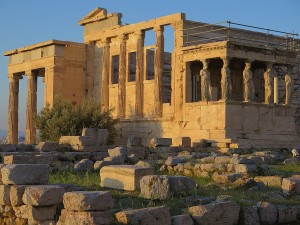
6 pm: Now walk back up Dionysiou Areopagitou to enter the Acropolis. This late in the afternoon is a magical time, when the city has cooled down and there are a fraction of the number of people who visit in droves during the morning hours. Now, it is so peaceful, you can linger, stroll around, read the markers, even get photos without hordes of people standing in front. We sit on a promontory that offers an amazing view of the city laid out in front of you, waiting for the sun to get lower and the colors to get more golden, and then go around shooting photos again, the colors of the stone columns becoming gold and orange. We even momentarily catch the Parthenon with no one else in front of it. For that instance, you feel as if the Parthenon is yours alone, as if you hold Western Civilization in your hands. I am struck by a bit of sadness, too, when I realize that the Parthenon is but a scabby skeleton of what it was (now that you have seen the video and the art in the museum), and what has been stripped away and lost forever. But the Greek Government is working to restore the Parthenon – a process that has been going on since Greece became an independent country, in 1821. After various false tries because of inadequate technology and knowledge in restoration, the government is working to replace the fabulous statuaries with replicas in just the exact places, leaving the originals in the museum where they are properly cared for.
(There is also a vigorous campaign to recover the artwork looted from the Acropolis by Lord Elgin when he was ambassador to the Ottoman Empire two centuries ago, and is pointedly made the villain in the museum’s video history of the Parthenon. Since 1816, the marble statues and reliefs taken by Elgin have been prize exhibits of the British Museum. Meanwhile, the Greeks had to make do with the leftovers, housed in a ramshackle museum built in 1874, that is still on the Hill. The Greeks built the New Acropolis Museum expressly as an argument that the Elgin marbles should be returned to Athens from the British Museum because there is finally a proper place to house and display them.)
What gets my eye is the Erechtheion, built about 420 BC, an Ionic temple that on one side, is supported with the six Caryatids- stunning statues of women– five of the originals are at the New Acropolis Museum (the sixth was one of the many artworks taken from the Acropolis by the British Lord Elgin).
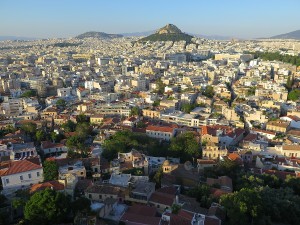
People wait here until the light is best – you only have a 10-minute window or so when the light is great and before the guards shoo you out
We leave finally when we are pushed out at around 7:30 pm by the guards – and get to watch the nightly formality as a contingent of soldiers come to secure the Acropolis). We come down to where people are on a rocky hill, with an incredible view of the sunset. We climb up, too, to take in the view.
Our perfect day is far from over, though.

8 pm: We walk down the Dionysiou Areopagitou (I use this wonderful boulevard as much as possible), cutting over to Rovertou Gali to the go to the Roof Garden Bar at the Hotel Herodion, with a stunning view of the Acropolis, lighted at night, a short walk after our late-afternoon visit, and a stone’s throw from the New Acropolis Museum (we can look through its windows at late-museum goers; the museum is open until 8 pm normally and until 10 pm on Friday nights). The Herodion’s bar offers a selection of imaginative cocktails. We enjoyed “Wisecrack Fizz,” with Pisco Barsol, st. Germain elderflower liqueur, fresh grapefruit juice, fresh lemon juice, and soda; a Hellas Fashioned, made with Metaxa 5, sugar, angostura bitters and rose water (one of the clever inventions of ‘Lefty’ the bartender), and 3 Cardinalsa, made with Midori, Frangelico, elderflower syrup, frsh lime juice and fresh orange juice, another of “Lefty’s” creations. the hotel also has a very fine restaurant (Hotel Herodion, 4 Rovertou Galli, Acropolis, Herodian.gr).

9:15 pm We get a couple of suggestions for our dinner, which gives us another wonderful excuse to walk through the Plaka to the Monastiraki district.
Thanassou restaurant is packed with people – we notice they are not tourists, but local people, enjoying the souvlaki and gyros. This part of the Monastiraki district is a little outside the most popular tourist area – in fact, restaurants and bistros and clever bars and coffee houses are opening throughout the district taking over where shops – like fabric stores – have been shuttered. The chicken souvlaki, served on pita, with yogurt, onions and tomatoes and french fries, is well done (about $12).
Acropolis Hill Hotel
By now, it is nearly midnight and I walk back to the Dionysiou Areopagitou toward my hotel, the Acropolis Hill Hotel, enjoying the street musicians virtually all along the way,
The new Acropolis Hill Hotel, which opened in the fall of 2010, is an “urban chic” luxury boutique hotel (at three-star hotel prices), nestled in the serene green, upscale residential area of Filopappou, virtually under the sacred rock of the Acropolis and a 15-minute walk from the Plaka. From the roof garden, it offers a lovely view of the Acropolis. It also has an outdoor swimming pool (in season), a lovely breakfast room where an ample buffet is served daily (including freshly prepared eggs, bacon and sausage; a selection of cereals, breads, cheeses, yogurt and fresh fruits), and a lobby lounge, plus free WiFi. My room also has a balcony, refrigerator, and flat screen TV with a selection of programming (7 Mousson Street, Gr 11 742, Filoppapou, info@acropolishill.gr, www.acropolishill.gr.)
The Acropolis Hill Hotel is one of five hotels in the Tour Hotel Group group:
The Arion Athens Hotel offers a wonderful from the roof top garden, free Wifi (18, Agio Dimitriou St., 105 54 Athens, www.arionhotel.gr, arion@tourhotel.gr).
Achilleas Hotel is a totally renovated hotel right in the heart of Athens commercial and business center, a two minute walk from Syntagma Square, a location next to the Acropolis Museums, Parliament, Emou shopping Street and the Syntagma metro station. It offers suite rooms ideal for families (Lekka 21 Str., 105 62 Athens, Greece, www.achilleashotel.gr, achilleas@tourhotel.gr).
For a different experience, the Kalamaki Beach Hotel is a resort-style property in the Peloponnese in a verdant area next to the emerald waters of the Saronic Gulf. It offers a swimming pool, tennis courts and children’s playground (www.kalamakibeach.gr).
(For more information, visit Tour Hotel Group, www.tourhotel.gr.)
If you have more time in Athens, here are some recommendations:
Take a walking tour such as Context Travel‘s “Acropolis Seminar” and Context Travel’s “Daily Life in Ancient Athens“ which together give a very comprehensive understanding of ancient Greece in a very intimate setting so that the guides can be very responsive to your interests and questions (info@contexttravel.com, www.contexttravel.com/city/athens (story to follow).
See Athens with a Native: “This is My Athens” program offered through the official city of Athens visitors’ website pairs visitors with a local Athenian volunteer who goes beyond the traditional guidebook sights to take you to local neighborhoods. You get matched with a volunteer by filling out a form at http://myathens.thisisathens.org/default.php?pname=homepage2&la=2 . For more info: http://myathens.thisisathens.org/ (story to follow)
The Jewish Museum of Greece offers fascinating exhibit where you can learn about Europe’s oldest Jewish settlement, 39 Nikis St., 105 57 Athens, Greece, info@jewishmuseum.gr, www.jewishmuseum.gr (hours are Monday-Friday, 9-2:30 pm, Sundays, 10-2 pm).
This is an exceptional time to visit Greece – the dollar is strong against the Euro and prices in Greece have been reduced. I had expected to see the kind of blight and deprivation that the US experienced as a result of the financial crisis of 2008, but apart from some graffiti (“We are artists, not vandals,” one proclaims), and some closed shops, the city is absolutely magnificent, vibrant and bustling, with many chic, new enterprises opening, and the people are welcoming and good natured.
Great planning tools are at www.thisisathens.org.
_______________________________
© 2015 Travel Features Syndicate, a division of Workstyles, Inc. All rights reserved. Visit www.examiner.com/eclectic-travel-in-national/karen-rubin, www.examiner.com/eclectic-traveler-in-long-island/karen-rubin, www.examiner.com/international-travel-in-national/karen-rubin, goingplacesfarandnear.com, and travelwritersmagazine.com/TravelFeaturesSyndicate/. Blogging at goingplacesnearandfar.wordpress.com and moralcompasstravel.info. Send comments or questions to FamTravLtr@aol.com. Tweet @TravelFeatures. ‘Like’ us at facebook.com/NewsPhotoFeatures. See our newest travel site at www.tidbitts.com/karen-rubin/where-in-the-world.

